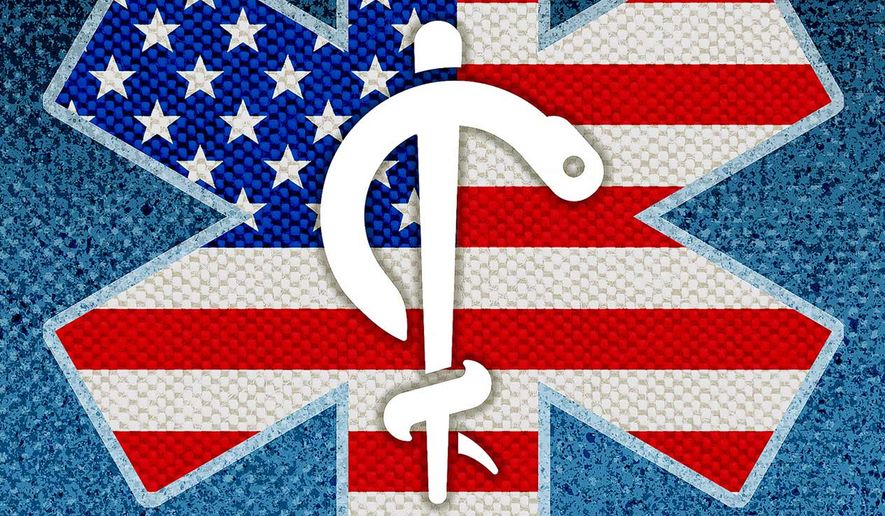OPINION:
Emergency medical technicians are almost always the first to arrive and provide lifesaving medical care for the critically injured. An EMT’s prime objective is to stabilize those in distress and, if necessary, move them safely to the hospital for further treatment. EMTs must think clearly and quickly in the most extreme of circumstances. They are often caring for someone who is likely experiencing one of the worst days of their life.
During my long career at the CIA, our prime objective was to detect and preempt the “left of boom” threats — before harm could be done to our homeland. The “boom” phase — the World Trade Center or the Pentagon on 9/11, or in any overseas war zone when terrorists strike — was not an everyday challenge in our line of work.
But EMTs work almost exclusively in the midst of the “boom” phase. The scene of an emergency is often chaotic, where some of the injured might be in shock or bleeding heavily. An EMT must rapidly assess the situation, engage with family members and witnesses, and move decisively to provide medical care to the people who need it most.
And that’s the mission retired CIA senior Clandestine Services Officer Patricia Moynihan chose after a stellar, decadeslong career recruiting spies and stealing secrets. During her intelligence career, Ms. Moynihan served with great distinction as a chief of base in a South Asian war zone and as a senior manager on some of the CIA’s most challenging and stressful overseas assignments.
And after just a few years riding the ambulance as an EMT, Ms. Moynihan took on another critical mission as the president of the McLean, Virginia, Volunteer Fire Department, a department with which my family has a deep personal connection.
I’ll never forget that summer night a few years back when my late wife, Kim, was two years into her fight against cancer. Kim was suffering from tremors and had a 103-degree fever. Knowing an ambulance would arrive at our home and administer first aid before I could make it to the hospital by car, I called 911. The McLean Volunteer Fire Department Emergency Medical Services team arrived within minutes and immediately began providing lifesaving treatment for Kim.
The second call I made was to our kind and thoughtful neighbor, who popped over and took our children to her home for an unexpected sleepover before the ambulance arrived, thereby sparing them the trauma of seeing their mom on a stretcher.
Supported by volunteer fire department members, Fairfax County Fire and Rescue personnel run the McLean Volunteer Fire Department, which was founded just over a century ago in 1921. Volunteers give at least 240 hours a year — some put in over 1,000 hours — on top of their day jobs in government or the private sector. The division of labor between full-time career fire and rescue employees and the volunteers is akin to that of active-duty and reserve units in the military. Volunteer EMTs and paramedics expand the department’s capacity in time of need and allow the most efficient use of finite resources.
I met Ms. Moynihan close to three decades ago when we were serving together at an embassy in the former Soviet Union. A former college athlete with a wicked sense of humor, she is a brilliant and creative problem-solver. Having cared for her late brother after he was diagnosed with brain cancer, she also has a deep sense of compassion.
Ms. Moynihan, whose father helped found the Southern Madison Volunteer Ambulance Corps in upstate New York, served as an EMT in college. After retiring from the CIA, she chose to return to community service.
Many of the skills Ms. Moynihan developed at the CIA apply to EMTs, who must assess the emergency scene and not overreact in a crisis. At the CIA, we called that “situational awareness.” After a call, EMTs write detailed after-action reports to learn from what went well and what could have gone better, just as good intelligence officers do.
As president of the McLean Volunteer Fire Department, Ms. Moynihan no longer goes out on ambulance runs, focusing now on solving administrative challenges such as recruitment and finances. Again, it’s very similar to the relationship she and I once knew between the CIA’s Langley headquarters (just down the road from McLean) and the overseas field stations on the front lines.
But despite the career shift, she retains that deep commitment to service above self. And while the intelligence community is focused on those wickedly complex, seemingly never-ending threats to our national security, Ms. Moynihan must derive some well-earned satisfaction from the greatest sense of accomplishment of all: Being part of an exceptional team with a distinguished record of saving lives.
• Daniel N. Hoffman is a retired clandestine services officer and former chief of station with the Central Intelligence Agency. His combined 30 years of government service included high-level overseas and domestic positions at the CIA. He has been a Fox News contributor since May 2018. Follow him on Twitter @DanielHoffmanDC.




Please read our comment policy before commenting.